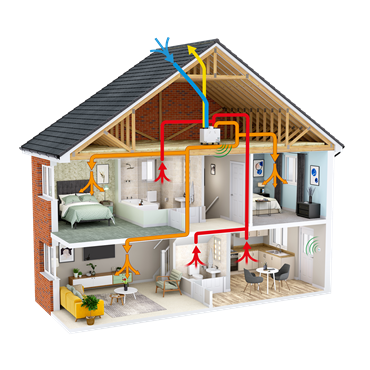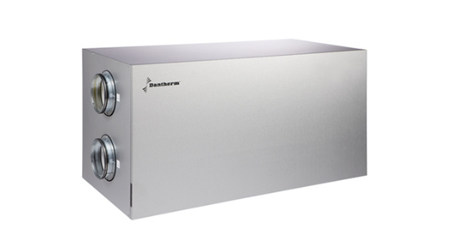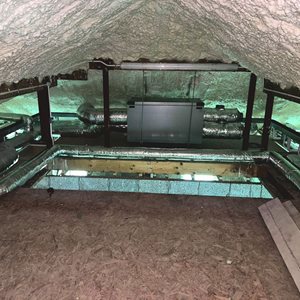Why Choose a Mechanical Ventilation with Heat Recovery System (MVHR)?
Date: 24 July 2023

For many years, homes have been ventilated via natural air filtration, resulting in high energy consumption for space heating, and at times, too little ventilation which can lead to poor indoor air quality and other, more readily visible impacts such as streaming windows, condensation and mould on indoor surfaces. New energy efficient homes are being built as airtight as possible through double or triple glazed windows, sealed doors and high levels of insulation. Keeping the heat in is a key factor, but consideration must be given to how you, and your home, can breathe.
Our range of Mechanical Ventilation with Heat Recovery Systems provide whole house ventilation and eliminate these potential issues.

MVHR Improves Indoor Air Quality
Fresh filtered air is continuously drawn into the home via the low energy unit. The ventilation unit filters the incoming air to remove pollutants and insects which can get into your home via any natural leakages such as letter boxes, trickle vents, extractor fans etc.
Filters within the MVHR units should be changed annually to help maintain system efficiency, prolong the life of the unit and ensure fresh quality air is always circulating around your home.
Constant Fresh, Filtered Indoor Air With MVHR 
Mechanical Ventilation with Heat Recovery Systems (MVHR) continuously draw fresh, filtered air into the home whilst also extracting moist, stale air from wet rooms such as the kitchen, utility room and bathrooms.
The system eliminates the need for traditional bathroom extractor fans and window trickle vents, both of which are considered natural leakage points and allow pollutants into your home. Continuously gently ventilating in the background, you can be sure that your home always has fresh air for you to breathe and that the system specifically designed for your home will have the correct air changes per hour, usually between 0.4-0.5 air changes per hour.
MVHR Reduces/Eliminates Surface Condensation
As MVHR provides the required air changes per hour through continual background ventilation, this helps prevent the build-up of moisture which can create surface condensation.
All BEAM MVHR systems comes standard with additional ventilation boost switches. The small wall mounted switches allow you to boost the extraction of stale moist air during times such as when showers and baths are being used. This helps prevent moisture build up which can result in streaming windows, musty odours, dampness, condensation and mould growth if not treated correctly.
MVHR Contributes to your Home's Energy Efficiency
Energy used for heating accounts for approximately 53% of all energy u se in the home and of this, 80% is lost through ventilation. MVHR Systems are considered the most energy efficient method of ventilating an airtight dwelling. They can recover up to 90% of this heat energy whilst providing essential fresh, filtered air throughout the home 24/7.
se in the home and of this, 80% is lost through ventilation. MVHR Systems are considered the most energy efficient method of ventilating an airtight dwelling. They can recover up to 90% of this heat energy whilst providing essential fresh, filtered air throughout the home 24/7.
With an MVHR system you eliminate the need for traditional window trickle vents and bathroom extractor fans which are considered natural leakages of the home.
All BEAM MVHR systems conform to requirements of UK and Ireland statutory Building Regulations and Technical Standards for Ventilation and BRE 398.
BEAM AXCO Counterflow MVHR Units
Beam’s AXCO Counterflow range of MVHR units are manufactured in the UK to the highest standards and are Energy Savings Trust (EST) Best Practice Compliant. The combination of extremely low power consumption and a highly efficient heat exchange is specifically  designed to enhance the building’s energy performance via SAP/DEAP assessment procedures.
designed to enhance the building’s energy performance via SAP/DEAP assessment procedures.
- Extremely low power consumption. Latest EC motors with SFP (Specific Fan Power) from 0.5 wls-1.
- Highly efficient heat exchange – up to 92% efficiency
- Unique design temperature-controlled summer bypass
BEAM AXCO HERU Rotary Wheel MVHR Units
Beam’s AXCO HERU range of rotary wheel MVHR units are  designed and built in Sweden and feature an energy-efficient rotor motor, as well as an innovative aluminium heat exchanger for optimal heat exchange.
designed and built in Sweden and feature an energy-efficient rotor motor, as well as an innovative aluminium heat exchanger for optimal heat exchange.
- Low energy, high performance EC fans
- Up to 86% heat recovery efficiency
- Increases thermal comfort by heat recovery or night cooling recovery
BEAM Passive House Range of MVHR Units
BEAM’s Passive House range is manufactured by Dantherm Air Handling and are certified by the PassivHaus Institut, featuring the latest energy saving technology. 
- Durable and efficient aluminium counterflow heat exchanger
- High efficiency – up to 95%
- EC motors with extremely low energy consumption
- G4/F7 pollen filters available
The Importance of choosing the correct MVHR Ducting System
One of the most important aspects of a well-planned, low energy and highly efficient MVHR System is the ducting type, design and quality of installation. Careful consideration to the design and choice of installation materials ensures your system delivers the correct ventilation rate and energy efficiency to your home.
well-planned, low energy and highly efficient MVHR System is the ducting type, design and quality of installation. Careful consideration to the design and choice of installation materials ensures your system delivers the correct ventilation rate and energy efficiency to your home.
The use of rigid, large diameter ducting is industry best practice providing a smooth flow of air with the least resistance, causing less noise (from both fans and air turbulence) and costing less to run. A minimum of 25mm aluminium foil backed wool insulation for ducting in a cold space is essential to retain high heat efficiency and avoid condensation forming in the ductwork. Solid ducting is resistant to crush damage during construction and therefore can be cleaned and maintained if required.
It is vital that an MVHR system is installed and commissioned correctly in accordance with the strict guidelines set by building regulations.
All BEAM MVHR systems have been independently tested at the Building Research Establishment (BRE). As well as ensuring clean, fresh filtered air throughout the home, our ventilation units:
- Are SAP Appendix Q listed
- Help improve SAP/BER ratings
- Comply with building regulations
- Are Energy Savings Trust compliant (AXCO C units)
- Are Passive House Certified Component (selected units)
Get in Touch
Hopefully this gives you a better idea of how MVHR works and why it needs careful consideration for your home. For more information and to discuss the option that suits your home and budget, contact our ventilation experts today on + 44 (0)28 7963 2424 or email info@beamcentralsystems.com